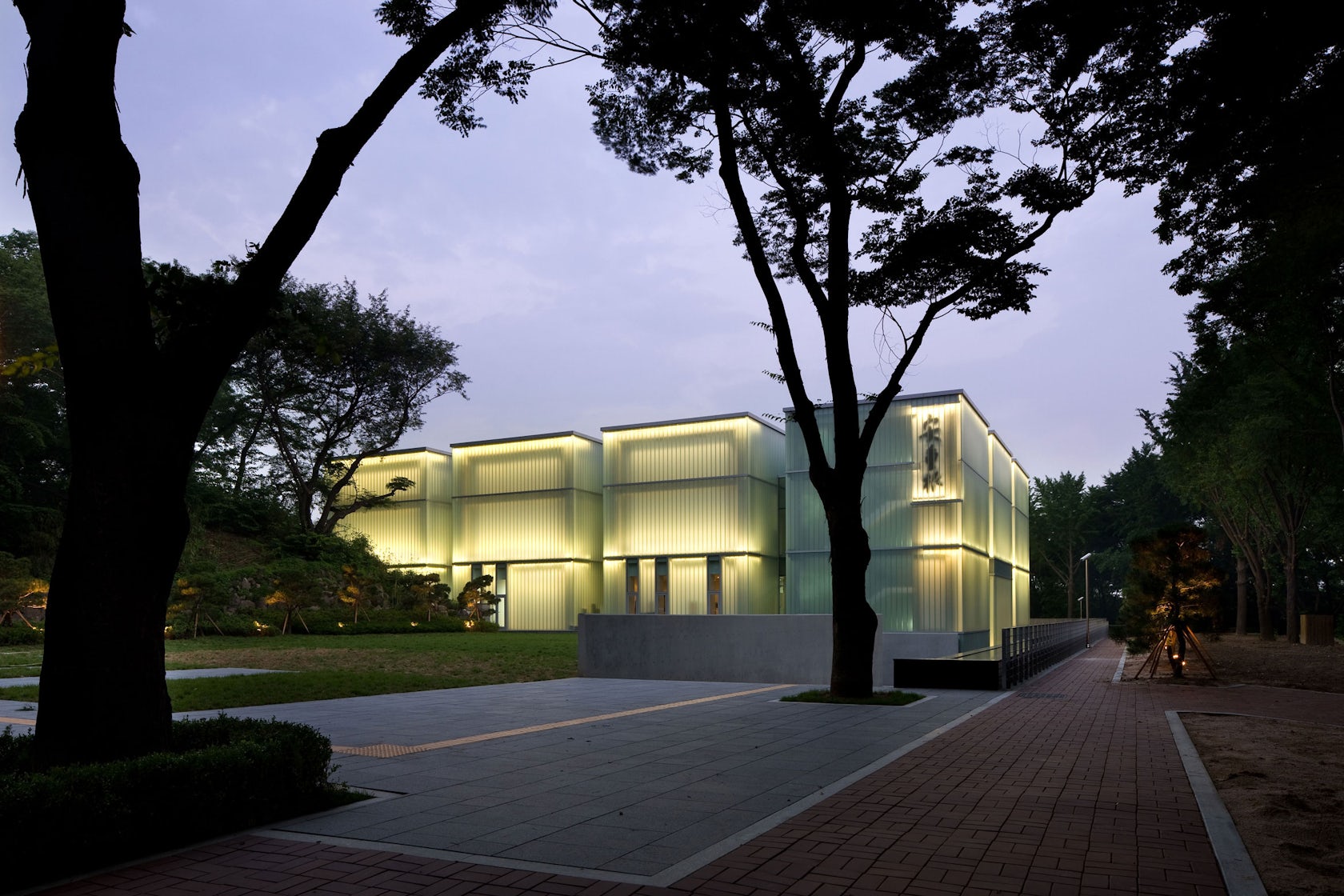Architects have found a place for polycarbonate panels in the modern home, but only after proving their worth in a number of nonresidential settings. Given what we now know about the connection between natural lighting and workplace productivity, it’s no surprise to find these light-permeable panels on the rise in modern offices. In their most basic implementation, as in popups like the “cloud room” at the National Art Museum of China, the panels are simply fastened to metal frames.
This low level of site-disturbance means polycarbonate panels are valuable for long-term installations, as well, like the deck pavilion on London’s Royal National Theatre. The blending effect they provide means they can depart from the material palette of a structure without greatly disturbing its color scheme.
When used in place of glass, they can take on a unique formal symbolism, as with South Korea’s Ahn Jung-geun Memorial Hall, where the visitor progresses from opaque volumes to one made of glass, providing a literal progression from obfuscation to transparency. Tinted variations lend themselves to the easy symbolism of, say, advertising the colors of a sports team. See for yourself below, with nine awesome examples of polycarbonate used in public and commercial structures.


Kwakkle Showroom by Wiel Arets Architects
On its curved front façade, everything but the clear glazed foyer of the showroom and office of materials distributor Kwakkel is covered by a translucent skin that, “combined with the various internal patios carved into the volume of the building, form various lighting effects along its articulated surface.” Wiel Arets Architects chose raw concrete for the floors and ceilings of this sinuous structure and broke up the second-floor spaces with open-air patio sections.

© alanwilliamsphotography.com

© alanwilliamsphotography.com
The Deck Pavilion by Madoc Architecture
Madoc Architecture’s 2008 deck pavilion provides an interesting complement to London’s high-brutalist Royal National Theatre with a polycarbonate exoskeleton that “shimmers on sunny days and camouflages itself with the concrete when the weather is overcast.” At night, a system of LEDs transports the dining area and events venue into a “glowing box of color.”

© Brut Deluxe

© Brut Deluxe
Totem De/Dos by Brut Deluxe Architecture + Design
These large road signs by Brut Deluxe were commissioned for three industrial parks in Madrid. The white LEDs inside their galvanized steel frames turn on with the street lamps.

© David de Armas

© David de Armas
Bernex and Confignon Fire Station by Bunq Architectes
Bunq Architectes’ modern fire station in Bernex, Switzerland, offers distinct façades for distinct programs: The industrial-style garage section is made of polycarbonate panels set in aluminum frames, while the staggered series of smaller volumes of the south-facing “domestic” side is clad in larch woodwork.

© D.LIM Architects

© D.LIM Architects
Ahn Jung-Geun Memorial Hall by D.LIM Architects
D.LIM Architects paid tribute to the life of Korean independence activist Ahn Jung-Geun with a number of symbolic referents in their design for this memorial hall. The 12 interconnected volumes are said to represent each member of Ahn’s secret society, the Dongeui Danjihoe. The route through the museum takes one through 11 polycarbonate-enclosed structures, ending at one clad in glass.

© Populous

© Populous
BBVA Compass Stadium by Populous
Christopher Lee of Populous described his work on Houston’s BBVA Compass Stadium as an attempt to “design the perfect urban soccer stadium: tight, atmospheric, and intimate.” The dynamic façade is made of panels of expanded metal mesh, with pedestrian-scaled openings highlighted in polycarbonate tinted orange, the team color of the Houston Dynamo.

© Khachaturian Architects

© Khachaturian Architects
Summer House by Khachaturian Architects
This pavilion in an industrial section of Moscow has a walls and ceilings of slatted wood made less permeable by a polycarbonate base. As the sun moves across the sky during the day, the space is “filled with different patterns of light and shadow.”

© ONE DESIGN INC

© ONE DESIGN INC
In 2011, Shanghai-based architect Bing Bu’s traveling Cloud Room installation arrived at the rooftop terrace of the National Art Museum of China in Beijing. The desired effect was creating a “cloud-like profile” as the white plastic panels pinned to the exterior turned in the wind.

© Bossley Architects

© Bossley Architects
Voyager NZ Maritime Museum by Bossley Architects
This extension to the New Zealand Maritime Museum by Bossley Architects contrasts the more traditional façade of the original structure with polycarbonate panels in varying shades of blues and greens, suggesting “the ephemeral and constantly shifting conditions of wind, light, and swell which are integral to the world of yachting.”
See Part II: Polycarbonate Panels Offer Affordable Ambiance in These 7 Abodes →




